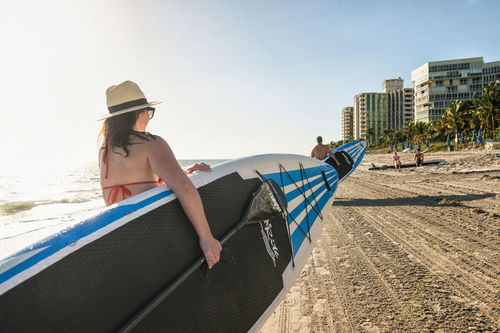What Muscles Does Paddleboarding Work?
Posted by Dunn Rite on Nov 1st 2019
Stand up paddleboarding can be a relaxing and fun activity that mostly anyone can do and it's also a great workout. People of all sizes, shapes and ages can make stand up paddleboarding a fun fitness activity. It's not only a complete body workout but is also a low-impact exercise that requires and helps build a combination of endurance, strength and balance.
What Is the Proper Stroke Technique for Stand Up Paddleboarding?
The proper stroke technique for stand up paddleboarding needs the body's muscles working together as one through each phase of the stroke. If you are doing it correctly then your core and back are actually doing most of the work. This can be a relief since those muscle groups are much stronger than the arms. If your arms are tiring quickly when paddleboarding, then you are likely using incorrect form. You can transfer the brunt of the stroke's resistance to the more powerful and bigger muscles of your body in order to paddle farther, faster and with less fatigue.
The core is the main power source for the proper stroke. Instead of relying on your shoulders or arms to pull the paddle to you, twist slightly in the chest and dip your stroke-side shoulder in order to engage your abdominal and oblique muscles to pull the body forward. Both core and back muscles are involved and engaged in this technique when done correctly.
A good stand up paddleboarding stroke involves twisting and hinging at the waist in order to pull your body toward the paddle. This technique takes the pressure off the upper arms. In order to fully engage the upper back, including the trapezius and deltoids, keep the lower arm straight when you plant and pull the paddle. Use your lower hand as leverage for the paddle shift. The upper arm should be hinged slightly at the elbow and push the grip forward. If you are doing it correctly then you will feel a squeeze between your shoulder blades and won't have fatigue in your shoulders and arms.
In order to optimize the paddleboarding stroke technique and get the most power out of the muscle groups, you should think of your shoulders as anchors between the power muscles (core and back) and your leverage limbs (arms). You want your shoulders constantly engaged but not being used as the primary power source for the stroke. Constantly lifting and pulling the paddle will demand a lot from your shoulders and strength will improve the performance of the other muscles involved.
Difference between Inflatable and Non-Inflatable Paddleboards
There are plenty of differences between inflatable stand up paddleboards and non-inflatable paddleboards but the muscle groups you work will be the same. Since hard paddleboards are more agile and have better glide your muscles may work a little harder when using a non-inflatable paddleboard.
Exercises to Help You Paddleboard Better
There are a number of different exercises you can do to strengthen the muscles you use while paddle boarding.
Dorsiflexion: The goal with this exercise is to strengthen ankle muscles for stability and balance. Attach a band around the top of the foot and something that doesn't move. Pull the mid foot toward your shin. Keep toes relaxed to focus on your ankle.
Single Arm Pull: The goal is to train the arms in order to move the paddle effectively. Pull a resistance band or cable slowly and stop the elbow at the side of the body.
Opposite Arm and Leg Reach: The goal is to strengthen the hamstrings with added instability. Work each leg one at a time so this can strengthen your weaker leg.
Plank Hold: Plank holds help strengthen the core and upper body muscles. This makes it easier to push up from the kneeling position on the paddleboard and get back down if needed. In order to make plank holds more challenging, lift one arm off the ground and reach toward the sky. This mimics the rotation needed when on the board with a paddle.
Squats: Squats will help strengthen the legs to help you get up and down from a kneeling position. Squats also help you stay in an athletic stance when rowing with the paddle. If you are able to touch the ground during your squats, it will help more with transitions on the paddleboard.
Dunn-Rite Pool Products & Pool Accessories
3rd Generation Family Owned Company with a long history of developing innovative products of the highest quality.
Pool Fountains - Combo Units - Pool Volleyball - Pool Basketball




